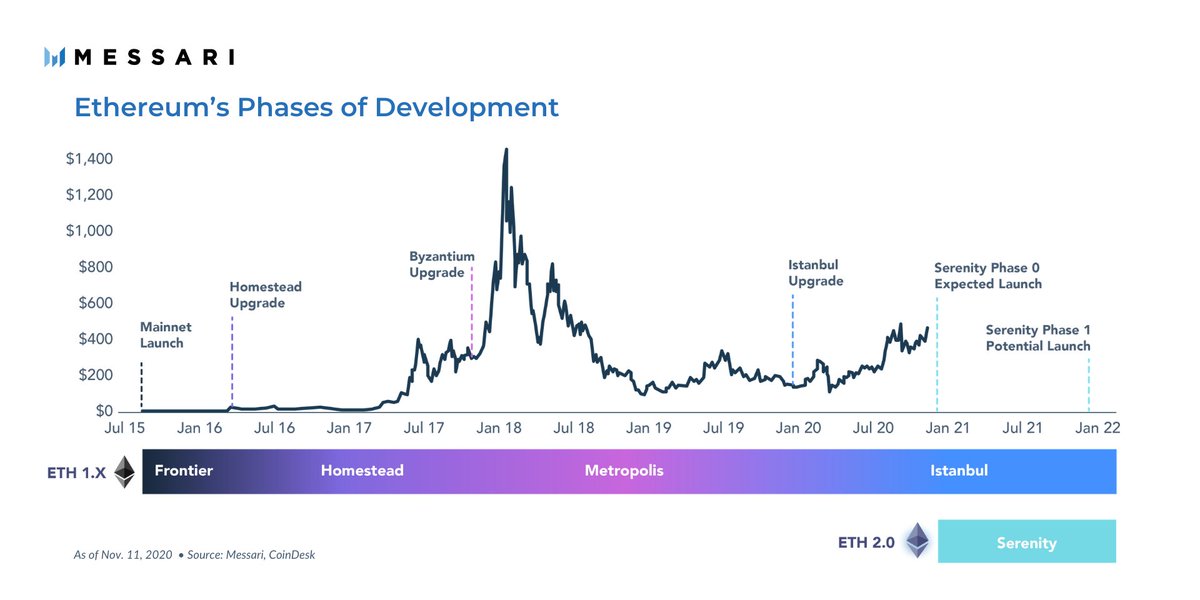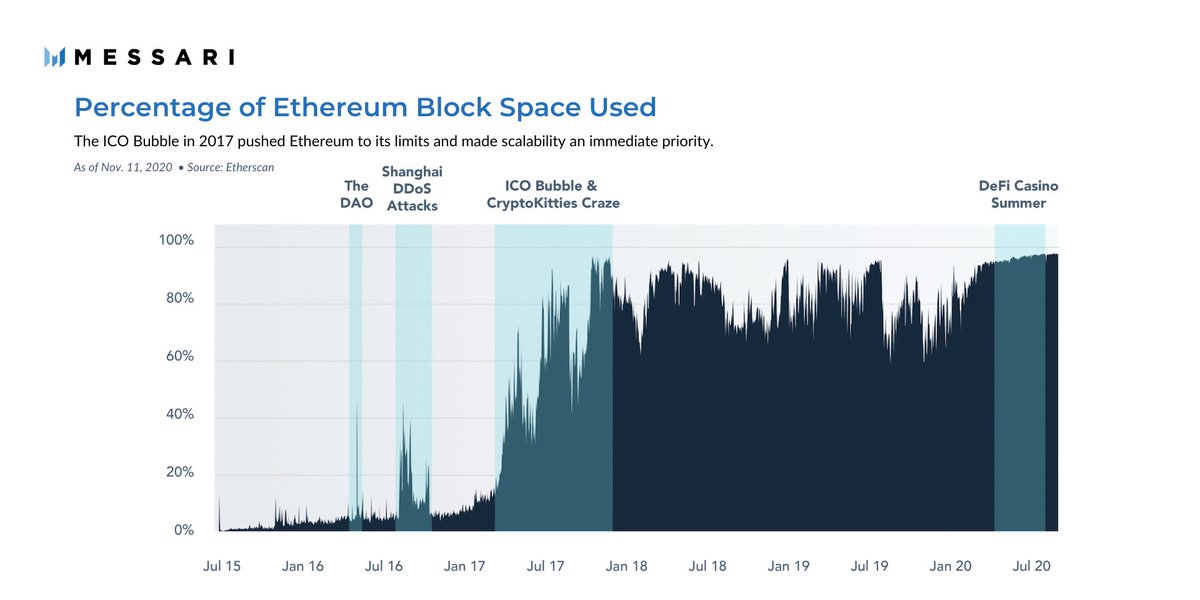The Beacon Chain’s launch is the culmination of countless research efforts dating back to 2013. It’s arrival kicks off Ethereum’s most ambitious upgrade to date - ETH 2.0, aka Serenity.
Why did it take so long? How did we get here?
Time for a trip into ETH 2.0's history
1/
Why did it take so long? How did we get here?
Time for a trip into ETH 2.0's history
1/
From the outset, Serenity sought to tackle 2 of crypto’s toughest problems: Proof of Stake & scalability.
The catch was to find a PoS design that didn’t compromise on security and a viable base layer scaling solution that preserved Ethereum’s core principle of decentralization.
The catch was to find a PoS design that didn’t compromise on security and a viable base layer scaling solution that preserved Ethereum’s core principle of decentralization.
In 2013/2014, PoS had two fatal security flaws: the nothing at stake problem and long-range attacks.
On the scalability front, no project had overcome the problem of requiring every full node to process every single transaction without introducing centralization.
On the scalability front, no project had overcome the problem of requiring every full node to process every single transaction without introducing centralization.
Starting in early 2014, it took Ethereum researchers about a year to uncover potential solutions to these problems - ones that would become the basis for ETH 2.0.
Simply put, these solutions were the use of validator security deposits, weak subjectivity, and sharding.
Simply put, these solutions were the use of validator security deposits, weak subjectivity, and sharding.
Validator security deposits, as envisioned by Vlad Zamfir in 2014 and backed by Vitalik, allow networks to enforce protocol rules by threatening to remove staked assets from faulty nodes.
Security deposits and associated penalties made double signing effectively unprofitable.
Security deposits and associated penalties made double signing effectively unprofitable.
Overcoming long-range attacks (when a validator creates a fork that begins in the distant past) was more of a mental hurdle.
Proof of Work networks protect against these attacks via intra-protocol means (objective).
PoS networks must mitigate them through extra-protocol means.
Proof of Work networks protect against these attacks via intra-protocol means (objective).
PoS networks must mitigate them through extra-protocol means.
Therefore, the use of PoS requires some form of social trust (or subjectivity) to be secure, which is antithetical within crypto.
But Ethereum researchers felt PoS offered enough advantages over PoW that accepting a small level of trust (“weak subjectivity”) was a fair tradeoff.
But Ethereum researchers felt PoS offered enough advantages over PoW that accepting a small level of trust (“weak subjectivity”) was a fair tradeoff.
For scaling, supernodes and relying entirely on second layer solutions to scale were non-starters.
Ethereum wanted to keep the base layer accessible to every user, which meant optimizing for node operator costs and network congestion.
Ethereum wanted to keep the base layer accessible to every user, which meant optimizing for node operator costs and network congestion.
Early scaling efforts explored sidechains (hub and spoke model) and interconnected “sub-states” (hypercubes). Each had some fragility issues.
But each new concept gravitated towards partitioning a network’s workload across multiple subgroups of nodes - the basis of sharding.
But each new concept gravitated towards partitioning a network’s workload across multiple subgroups of nodes - the basis of sharding.
Gavin Wood also contributed to this scaling research.
His 2015 proposal described sharding a network’s data across many sub-chains that plug into a single coordination layer.
Wood later pivoted this into Polkadot, but its core idea lives on in ETH 2.0’s Beacon Chain.
His 2015 proposal described sharding a network’s data across many sub-chains that plug into a single coordination layer.
Wood later pivoted this into Polkadot, but its core idea lives on in ETH 2.0’s Beacon Chain.
By late 2015, Vlad Zamfir’s security deposit-based PoS (called Casper) and sharding had become focal points of Serenity’s design and proof of concepts.
What lay ahead for researchers was turning these theoretical solutions into working products, an effort that took years.
What lay ahead for researchers was turning these theoretical solutions into working products, an effort that took years.
Vitalik has noted these middle years included several failed attempts at finalizing these core features.
Progress also stalled briefly when research teams directed resources away from Serenity to deal with The DAO fork in June 2016 and the Shanghai attacks several months later.
Progress also stalled briefly when research teams directed resources away from Serenity to deal with The DAO fork in June 2016 and the Shanghai attacks several months later.
Everything changed in 2017.
The infamous ICO boom and CryptoKitties craze pushed Ethereum to limits, making scalability a top priority overnight.
This bull run supplied the Ethereum Foundation with enough motivation and funding to supercharge ETH 2.0 development efforts.
The infamous ICO boom and CryptoKitties craze pushed Ethereum to limits, making scalability a top priority overnight.
This bull run supplied the Ethereum Foundation with enough motivation and funding to supercharge ETH 2.0 development efforts.
Ethereum’s rise in popularity also introduced another hurdle: how would ETH 2.0 teams implement the upgrade without disrupting ongoing activity?
Minimizing disruption to the exiting chain is why research teams initially explored implementing PoS via a smart contract on ETH 1.
Minimizing disruption to the exiting chain is why research teams initially explored implementing PoS via a smart contract on ETH 1.
The real turning point in Serenity’s history came in 2018.
Until mid-2018, Ethereum’s PoS and sharding research groups operated independently, with each team building a minimally invasive smart contract-based solution to deploy on Ethereum.
Until mid-2018, Ethereum’s PoS and sharding research groups operated independently, with each team building a minimally invasive smart contract-based solution to deploy on Ethereum.
Despite their different objectives, each team ran into similar issues building on ETH 1. They also shared several core features.
A solution arrived in a June 2018 proposal: combine their efforts by building PoS and sharding on an entirely new network, dubbed the Beacon Chain.
A solution arrived in a June 2018 proposal: combine their efforts by building PoS and sharding on an entirely new network, dubbed the Beacon Chain.
It was a shift in strategy that would both isolate the existing network from any growing pains on ETH 2.0 and make it easier to integrate Ethereum’s chosen solutions of PoS and sharding over a multi-phase, multi-year process.
PoS → Sharding → Merge the two networks → Serenity
PoS → Sharding → Merge the two networks → Serenity
While some details have been adjusted, the vision for ETH 2.0 has remained largely unchanged since.
So why the two-year gap between the pivot and the Beacon Chain’s arrival?
To paraphrase Danny Ryan, building sophisticated systems is complicated.
So why the two-year gap between the pivot and the Beacon Chain’s arrival?
To paraphrase Danny Ryan, building sophisticated systems is complicated.
Since 2018, ETH 2.0 devs have required time to:
- Formalize the Beacon Chain’s design
- Establish multiple viable client implementations
- Run the code through several audits and testnets
- Advance the process of aggregating validator signatures https://www.reddit.com/r/ethfinance/comments/jghide/daily_general_discussion_october_23_2020/g9sz7jm/?context=8&depth=9
- Formalize the Beacon Chain’s design
- Establish multiple viable client implementations
- Run the code through several audits and testnets
- Advance the process of aggregating validator signatures https://www.reddit.com/r/ethfinance/comments/jghide/daily_general_discussion_october_23_2020/g9sz7jm/?context=8&depth=9
Which leads us to today, the launch of the Beacon Chain. The 1st phase of ETH 2.0’s multi-stage rollout and the moment where ETH holders can become stakers for the 1st time.
None of this would have been possible without several years of wading through crypto’s toughest problems.
None of this would have been possible without several years of wading through crypto’s toughest problems.
There’s still plenty of work ahead, as the designs for ETH 2.0’s subsequent phases are unfinished.
But the launch of the Beacon Chain is a monumental milestone that marks the start of a new era in Ethereum’s history: the future of the crypto economy.
But the launch of the Beacon Chain is a monumental milestone that marks the start of a new era in Ethereum’s history: the future of the crypto economy.
See a more completed history on ETH 2.0 in the report @RyanWatkins_ and I put together.
The Beacon Chain’s launch is an exciting first step, and we tried to cover everything you’d want to know about it. https://messari.io/road-to-eth2
The Beacon Chain’s launch is an exciting first step, and we tried to cover everything you’d want to know about it. https://messari.io/road-to-eth2

 Read on Twitter
Read on Twitter



